Applicability Analysis of Three Atmospheric Radiative Transfer Models in Nighttime
Abstract
1. Introduction
2. Materials and Methods
2.1. Research Region
2.2. Data Collection
2.2.1. Nighttime Light Data
- (1)
- The research region is focused on the DNB pixel corresponding to the central location of the Baotou Field, extending outwards to a range of 10 km × 10 km.
- (2)
- The lunar zenith angle is less than 90°, meaning the moon is positioned above the horizon. This ensures that the lunar illumination can effectively illuminate the target pixel area.
- (3)
- The lunar phase angle is less than 120°, meaning more than two-thirds of the lunar phase is illuminated. This ensures an adequate downward illumination of the top of the atmosphere.
2.2.2. Surface Reflectance Data
2.2.3. Aerosol Optical Depth Data
2.2.4. Lunar Irradiance Data
2.3. Methods
- (1)
- Data collection and processing: This study used SNPP satellite data, surface reflectance data, aerosol optical depth data, lunar irradiance data, and DNB spectral response function. The SNPP satellite data were processed by Geographic Lookup Table (GLT) correction. The surface reflectance data are reprojected to the WGS84 coordinate system. The aerosol optical depth at 550 nm was obtained by interpolating aerosol data. The resolution of lunar irradiance data is converted into three formats: 1 nm, 0.5 nm, and 1 cm−1.
- (2)
- Model construction: This study analyzes the characteristics of lunar radiation for the MT2009 lunar irradiance model. The lunar irradiance is introduced into MODTRAN, SCIATRAN, and 6SV, and the lunar illumination is used as the radiation source of the atmospheric radiative transfer model.
- (3)
- Model precision evaluation: The radiance value of the SVDNB product was used as a benchmark to evaluate the accuracy of simulated values from three nighttime atmospheric radiation transfer models. Then, the accuracy of the nighttime atmospheric radiative transfer model is evaluated by calculating the average relative error.
- (4)
- Model sensitivity analysis: Utilizing the nighttime atmospheric radiative transfer model, calculated the sensitivity of different parameters to the TOA radiance, including lunar phases, aerosol optical depths, surface reflectances, lunar zenith angles, and observation zenith angles. Concurrently, the applicability of the atmospheric radiative transfer model under different conditions is further analyzed.
2.3.1. Principle of Atmospheric Radiative Transfer at Nighttime
2.3.2. Construction Process of Nighttime Atmospheric Radiative Transfer Models
2.3.3. Parameter Settings of Nighttime Atmospheric Radiative Transfer Models
3. Results
3.1. Models Precision Evaluation
3.2. Sensitivity Analysis
4. Discussion
5. Conclusions
- (1)
- In this study, the relative error range for Night-SCIATRAN is −14.8% ± 8.2%, that for Night-6SV is 66.6% ± 8.8%, and for Night-MODTRAN is 3.1% ± 2.5%. The results indicate that the simulation accuracy of Night-MODTRAN is optimal for nighttime radiative transfer simulations.
- (2)
- By calculating the relative error between simulated and DNB radiance, it has been found that when the lunar phase angle is smaller, the simulated TOA radiance is usually higher than the DNB radiance. Conversely, when the lunar phase angle is larger, the simulated TOA radiance is usually lower than the DNB radiance. The absolute error fluctuation tends to be stable near the lunar phase angle of 90°.
- (3)
- In this study, the simulated TOA radiance is sensitive to the changes in the lunar phase angle, aerosol optical depth, surface reflectance, and lunar zenith angle, and the average change rates are 68%, 100%, 2561%, and 75%. However, the simulated TOA radiance is not sensitive to the changes in satellite zenith angle and relative azimuth angle, and the average change rates are 20% and 0%.
Author Contributions
Funding
Institutional Review Board Statement
Informed Consent Statement
Data Availability Statement
Acknowledgments
Conflicts of Interest
Appendix A
| NO. | Lunar Phase Angle | Aerosol Optical Depth | Surface Reflectance | Lunar Zenith Angle | Lunar Azimuth Angle | Satellite Zenith Angle | Satellite Azimuth Angle |
|---|---|---|---|---|---|---|---|
| 1 | 73° | 0.189 | 0.195 | 84.78° | −65.63° | 26.02° | −74.81° |
| 2 | 61° | 0.187 | 0.196 | 73.31° | −78.72° | 2.54° | 90.39° |
| 3 | 37° | 0.142 | 0.200 | 60.93° | 161.26° | 44.44° | 96.39° |
| 4 | 50° | 0.189 | 0.201 | 70.58° | 144.89° | 59.19° | 92.94° |
| 5 | 78° | 0.263 | 0.207 | 83.31° | −73.27° | 37.93° | 97.44° |
| 6 | 95° | 0.164 | 0.205 | 85.29° | 102.16° | 44.75° | 96.35° |
| 7 | 28° | 0.075 | 0.196 | 51.59° | −174.26° | 16.98° | −75.78° |
| 8 | 50° | 0.134 | 0.187 | 49.12° | 137.58° | 38.05° | 97.35° |
| 9 | 94° | 0.162 | 0.197 | 56.23° | 88.11° | 2.67° | 100.84° |
| 10 | 5° | 0.094 | 0.200 | 61.82° | −137.38° | 7.53° | −78.86° |
| 11 | 78° | 0.342 | 0.208 | 83.11° | −77.43° | 38.21° | 96.79° |
| 12 | 89° | 0.116 | 0.198 | 72.43° | 107.84° | 21.68° | 99.26° |
| 13 | 81° | 0.135 | 0.187 | 66.80° | 100.68° | 62.72° | 92.20° |
| 14 | 103° | 0.139 | 0.187 | 64.94° | 89.14° | 8.11° | −78.68° |
| 15 | 109° | 0.182 | 0.163 | 71.89° | 73.12° | 29.79° | 97.78° |
| 16 | 89° | 0.219 | 0.170 | 63.09° | 81.66° | 54.49° | 93.91° |
| 17 | 112° | 0.194 | 0.172 | 74.14° | 82.80° | 26.86° | −75.05° |
| 18 | 82° | 0.112 | 0.182 | 60.94° | 101.24° | 18.47° | −76.62° |
| 19 | 93° | 0.169 | 0.181 | 65.86° | 94.06° | 11.06° | 100.64° |
| 20 | 14° | 0.195 | 0.214 | 54.80° | −132.70° | 21.90° | 98.90° |
| 21 | 32° | 0.106 | 0.215 | 80.50° | −104.20° | 62.90° | −68.20° |
| 22 | 6° | 0.105 | 0.214 | 70.40° | −138.10° | 33.30° | −74.90° |
| 23 | 64° | 0.232 | 0.217 | 72.70° | 148.70° | 40.10° | −73.40° |
| 24 | 33° | 0.166 | 0.216 | 66.90° | 178.30° | 33.30° | −74.40° |
| 25 | 49° | 0.054 | 0.179 | 43.16° | 149.85° | 2.02° | 99.35° |
| 26 | 78° | 0.390 | 0.178 | 41.41° | 99.49° | 1.77° | 89.59° |
| 27 | 89° | 0.208 | 0.180 | 52.99° | 85.64° | 29.78° | 98.53° |
| 28 | 102° | 0.145 | 0.200 | 64.45° | 80.66° | 1.94° | 111.13° |
| 29 | 113° | 0.218 | 0.201 | 78.36° | 74.03° | 40.73° | 98.59° |
| 30 | 99° | 0.467 | 0.188 | 79.35° | 98.95° | 7.07° | −78.97° |
References
- Lyapustin, A.; Wang, Y.; Choi, M.; Xiong, X.; Angal, A.; Wu, A.; Doelling, D.R.; Bhatt, R.; Go, S.; Korkin, S.; et al. Calibration of the SNPP and NOAA 20 VIIRS sensors for continuity of the MODIS climate data records. Remote Sens. Environ. 2023, 295, 113717. [Google Scholar] [CrossRef]
- Cui, Z.; Ma, C.; Zhang, H.; Hu, Y.; Yan, L.; Dou, C.; Li, X.M. Vicarious Radiometric Calibration of the Multispectral Imager Onboard SDGSAT-1 over the Dunhuang Calibration Site, China. Remote Sens. 2023, 15, 2578. [Google Scholar] [CrossRef]
- Zhang, Q.; Zhao, Y.; Zhang, L.; Wu, J.; Li, W.; Yan, J.; Jiang, X.; Yan, Z.; Zhao, J. On-Orbit Radiometric Calibration of Hyperspectral Sensors on Board Micro-Nano Satellite Constellation Based on RadCalNet Data. Remote Sens. 2022, 14, 4720. [Google Scholar] [CrossRef]
- Chen, Y.; Sun, K.; Li, W.; Hu, X.; Li, P.; Bai, T. Vicarious Calibration of FengYun-3D MERSI-II at Railroad Valley Playa Site: A Case for Sensors with Large View Angles. Remote Sens. 2021, 13, 1347. [Google Scholar] [CrossRef]
- Che, H.; Zhang, X.; Chen, H.; Damiri, B.; Goloub, P.; Li, Z.; Zhang, X.; Wei, Y.; Zhou, H.; Dong, F. Instrument calibration and aerosol optical depth validation of the China Aerosol Remote Sensing Network. J. Geophys. Res. Atmos. 2009, 114, D03206. [Google Scholar] [CrossRef]
- Hu, X.; Liu, J.; Sun, L.; Rong, Z.; Li, Y.; Zhang, Y.; Zheng, Z.; Wu, R.; Zhang, L.; Gu, X. Characterization of CRCS Dunhuang test site and vicarious calibration utilization for Fengyun (FY) series sensors. Can. J. Remote Sens. 2014, 36, 566–582. [Google Scholar] [CrossRef]
- Min, M.; Deng, J.; Liu, C.; Guo, J.; Lu, N.; Hu, X.; Chen, L.; Zhang, P.; Lu, Q.; Wang, L. An investigation of the implications of lunar illumination spectral changes for Day/Night Band-based cloud property retrieval due to lunar phase transition. J. Geophys. Res. Atmos. 2017, 122, 9233–9244. [Google Scholar] [CrossRef]
- Qiu, S.; Shao, X.; Cao, C.Y.; Uprety, S.; Wang, W.H. Assessment of straylight correction performance for the VIIRS Day/Night Band using Dome-C and Greenland under lunar illumination. Int. J. Remote Sens. 2017, 38, 5880–5898. [Google Scholar] [CrossRef]
- Xi, S.; Changyong, C.; Sirish, U. Vicarious calibration of S-NPP/VIIRS day-night band. Proc. SPIE 2013, 8866, 88661S. [Google Scholar] [CrossRef]
- Zakharov, Y.N.; Popov, A.Y.; Tyurin, A.V. Semiconductor laser’s on-line coherence calibration and testing of frequency stability. Proc. SPIE 2008, 7008, 70081P. [Google Scholar] [CrossRef]
- Cao, C.; Bai, Y. Quantitative Analysis of VIIRS DNB Nightlight Point Source for Light Power Estimation and Stability Monitoring. Remote Sens. 2014, 6, 11915–11935. [Google Scholar] [CrossRef]
- Ma, S.; Yan, W.; Huang, Y.; Jiang, J.; Hu, S.; Wang, Y. Calibration Method of Low-Light Sensor Based on Bridge Lights. J. Atmos. Ocean. Technol. 2016, 33, 1123–1134. [Google Scholar] [CrossRef]
- Hu, S.; Ma, S.; Yan, W.; Lu, W.; Zhao, X. Feasibility of a specialized ground light source for night-time low-light calibration. Int. J. Remote Sens. 2018, 39, 2543–2559. [Google Scholar] [CrossRef]
- Yang, H.; Zhou, J.; Weng, F.; Sun, N.; Anderson, K.; Liu, Q.; Kim, E.J. Developing Vicarious Calibration for Microwave Sounding Instruments Using Lunar Radiation. IEEE T. Geosci. Remote 2018, 56, 6723–6733. [Google Scholar] [CrossRef]
- Ryan, R.E.; Pagnutti, M.; Burch, K.; Leigh, L.; Ruggles, T.A.; Cao, C.; Aaron, D.; Blonski, S.; Helder, D.L. The Terra Vega Active Light Source: A First Step in a New Approach to Perform Nighttime Absolute Radiometric Calibrations and Early Results Calibrating the VIIRS DNB. Remote Sens. 2019, 11, 710. [Google Scholar] [CrossRef]
- Elvidge, C.D.; Baugh, K.E.; Zhizhin, M.; Hsu, F.-C. Why VIIRS data are superior to DMSP for mapping nighttime lights. Proc. Asia-Pac. Adv. Netw. 2013, 35, 62. [Google Scholar] [CrossRef]
- Liao, L.B.; Weiss, S.; Mills, S.; Hauss, B. Suomi NPP VIIRS day-night band on-orbit performance. J. Geophys. Res. Atmos. 2013, 118, 12705–12718. [Google Scholar] [CrossRef]
- Qiu, S.; Shao, X.; Cao, C.; Uprety, S. Feasibility demonstration for calibrating Suomi-National Polar-Orbiting Partnership Visible Infrared Imaging Radiometer Suite day/night band using Dome C and Greenland under moon light. J. Appl. Remote Sens. 2016, 10, 16024. [Google Scholar] [CrossRef]
- Hu, S.; Ma, S.; Yan, W.; Huang, Y. Using two different targets for the calibration of S-NPP VIIRS day night band under lunar illumination. Proc. SPIE 2016, 10255, 102552O. [Google Scholar] [CrossRef]
- Hu, S. VIIRS Low-Light Channel Data Radiometric Calibration and Application Technology. Ph.D. Dissertation, National University of Defense Technology, Wuhan, China, 2019; pp. 27–38. [Google Scholar]
- Ma, S.; Yan, W.; Huang, Y.-X.; Ai, W.-H.; Zhao, X. Vicarious calibration of S-NPP/VIIRS day–night band using deep convective clouds. Remote Sens. Environ. 2015, 158, 42–55. [Google Scholar] [CrossRef]
- Li, X.; Elvidge, C.; Zhou, Y.; Cao, C.; Warner, T. Remote sensing of night-time light. Int. J. Remote Sens. 2017, 38, 5855–5859. [Google Scholar] [CrossRef]
- Li, Y.; Chen, M.; Liu, J.; Zhang, Z.; Gao, W. Enhancing research and application of urban rainwater harvesting and utilisation. Inn. Mong. Water Resour. 2007, 4, 120–121. [Google Scholar]
- Tang, H.; Xiao, C.; Shang, K.; Wu, T.; Li, Q. Radiometric Calibration of GF5-02 Advanced Hyperspectral Imager Based on RadCalNet Baotou Site. Remote Sens. 2023, 15, 2233. [Google Scholar] [CrossRef]
- Barreto, Á.; Cuevas, E.; Granados-Muñoz, M.-J.; Alados-Arboledas, L.; Romero, P.M.; Gröbner, J.; Kouremeti, N.; Almansa, A.F.; Stone, T.; Toledano, C.; et al. The new sun-sky-lunar Cimel CE318-T multiband photometer—A comprehensive performance evaluation. Atmos. Meas. Tech. 2016, 9, 631–654. [Google Scholar] [CrossRef]
- Hlaing, S.; Harmel, T.; Gilerson, A.; Foster, R.; Weidemann, A.; Arnone, R.; Wang, M.; Ahmed, S. Evaluation of the VIIRS ocean color monitoring performance in coastal regions. Remote Sens. Environ. 2013, 139, 398–414. [Google Scholar] [CrossRef]
- Wolfe, R.E.; Lin, G.; Nishihama, M.; Tewari, K.P.; Tilton, J.C.; Isaacman, A.R. Suomi NPP VIIRS prelaunch and on-orbit geometric calibration and characterization. J. Geophys. Res. Atmos. 2013, 118, 11508–11521. [Google Scholar] [CrossRef]
- Hu, S.; Ma, S.; Yan, W.; Jiang, J.; Huang, Y. A new multichannel threshold algorithm based on radiative transfer characteristics for detecting fog/low stratus using night-time NPP/VIIRS data. Int. J. Remote Sens. 2016, 38, 5919–5933. [Google Scholar] [CrossRef]
- Ma, Y.; Zhang, W.; Zhang, L.; Gu, X.; Yu, T. Estimation of Ground-Level PM2.5 Concentration at Night in Beijing-Tianjin-Hebei Region with NPP/VIIRS Day/Night Band. Remote Sens. 2023, 15, 825. [Google Scholar] [CrossRef]
- Ma, Y.; Zhang, W.; Chen, X.; Zhang, L.; Liu, Q. High Spatial Resolution Nighttime PM2.5 Datasets in the Beijing–Tianjin–Hebei Region from 2015 to 2021 Using VIIRS/DNB and Deep Learning Model. Remote Sens. 2023, 15, 4271. [Google Scholar] [CrossRef]
- Chen, H.; Xiong, X.; Sun, C.; Chen, X.; Chiang, K. Suomi-NPP VIIRS day-night band on-orbit calibration and performance. J. Appl. Remote Sens. 2017, 11, 036019. [Google Scholar] [CrossRef]
- He, Q.; Zhang, M.; Huang, B.; Tong, X. MODIS 3 km and 10 km aerosol optical depth for China: Evaluation and comparison. Atmos. Environ. 2017, 153, 150–162. [Google Scholar] [CrossRef]
- Zhang, W.; Xu, H.; Zheng, F. Aerosol Optical Depth Retrieval over East Asia Using Himawari-8/AHI Data. Remote Sens. 2018, 10, 137. [Google Scholar] [CrossRef]
- Zhang, W.; Xu, H.; Zhang, L. Assessment of Himawari-8 AHI Aerosol Optical Depth over Land. Remote Sens. 2019, 11, 1108. [Google Scholar] [CrossRef]
- Zeng, X.; Li, C. The Influence of Heterogeneity on Lunar Irradiance Based on Multiscale Analysis. Remote Sens. 2019, 11, 2696. [Google Scholar] [CrossRef]
- Mauceri, S.; Pilewskie, P.; Woods, T.; Béland, S.; Richard, E. Intercomparing Solar Spectral Irradiance from SORCE SIM. Earth Space Sci. 2020, 7, e2019EA001002. [Google Scholar] [CrossRef]
- Bassani, C.; Sterckx, S. Calibration of Satellite Low Radiance by AERONET-OC Products and 6SV Model. Remote Sens. 2021, 13, 781. [Google Scholar] [CrossRef]
- Mei, L.; Rozanov, V.; Rozanov, A.; Burrows, J.P. SCIATRAN software package (V4.6): Update and further development of aerosol, clouds, surface reflectance databases and models. Geosci. Model Dev. 2023, 16, 1511–1536. [Google Scholar] [CrossRef]
- Yakunin, M.A.; Yurchenko, A.V. MODTRAN5 simulations of responses from MODIS spectroradiometer channels. Tech. Phys. 2015, 60, 141–144. [Google Scholar] [CrossRef]
- Wang, J.; Zhou, M.; Xu, X.; Roudini, S.; Sander, S.P.; Pongetti, T.J.; Miller, S.D.; Reid, J.S.; Hyer, E.; Spurr, R. Development of a nighttime shortwave radiative transfer model for remote sensing of nocturnal aerosols and fires from VIIRS. Remote Sens. Environ. 2020, 241, 111727. [Google Scholar] [CrossRef]
- Okpalaonwuka, C.; Olusegun, C.F.; Olusola, A.; Ogunjo, S. Validation of MODIS AOD retrievals in West Africa: A comparison with AERONET observations. Air Qual. Atmos. Health 2023, 16, 2085–2094. [Google Scholar] [CrossRef]
- Li, J.; Qiu, S.; Zhang, Y.; Gao, C.; Qian, Y.; Liu, Y. Performance assessments of VIIRS DNB on-orbit radiometric calibration accuracy and stability on SNPP and NOAA-20. J. Infrared Millim. Waves 2021, 40, 809–819. [Google Scholar] [CrossRef]
- Min, M.; Zheng, J.; Zhang, P.; Hu, X.; Chen, L.; Li, X.; Huang, Y.; Zhu, L. A low-light radiative transfer model for satellite observations of moonlight and earth surface light at night. J. Quant. Spectrosc. Radiat. Transf. 2020, 247, 106954. [Google Scholar] [CrossRef]
- Feng, Q.; Yang, P.; Kattawar, G.W.; Hsu, C.N.; Tsay, S.-C.; Laszlo, I. Effects of particle nonsphericity and radiation polarization on retrieving dust properties from MODIS observations. J. Aerosol. Sci. 2009, 40, 776–789. [Google Scholar] [CrossRef]
- Stathopoulou, M.; Cartalis, C. Downscaling AVHRR land surface temperatures for improved surface urban heat island intensity estimation. Remote Sens. Environ. 2009, 113, 2592–2605. [Google Scholar] [CrossRef]
- Zhao, Y.; Qu, Z.; Zhang, Y.; Ao, Y.; Han, L.; Kang, S.; Sun, Y. Effects of human activity intensity on habitat quality based on nighttime light remote sensing: A case study of Northern Shaanxi, China. Sci. Total. Environ. 2022, 851 Pt 1, 158037. [Google Scholar] [CrossRef]
- Deng, J.; Qiu, S.; Zhang, Y.; Cui, H.; Li, K.; Cheng, H.; Liu, Z.; Dou, X.; Qian, Y. Estimating Nighttime PM2.5 Concentration in Beijing Based on NPP/VIIRS Day/Night Band. Remote Sens. 2023, 15, 349. [Google Scholar] [CrossRef]

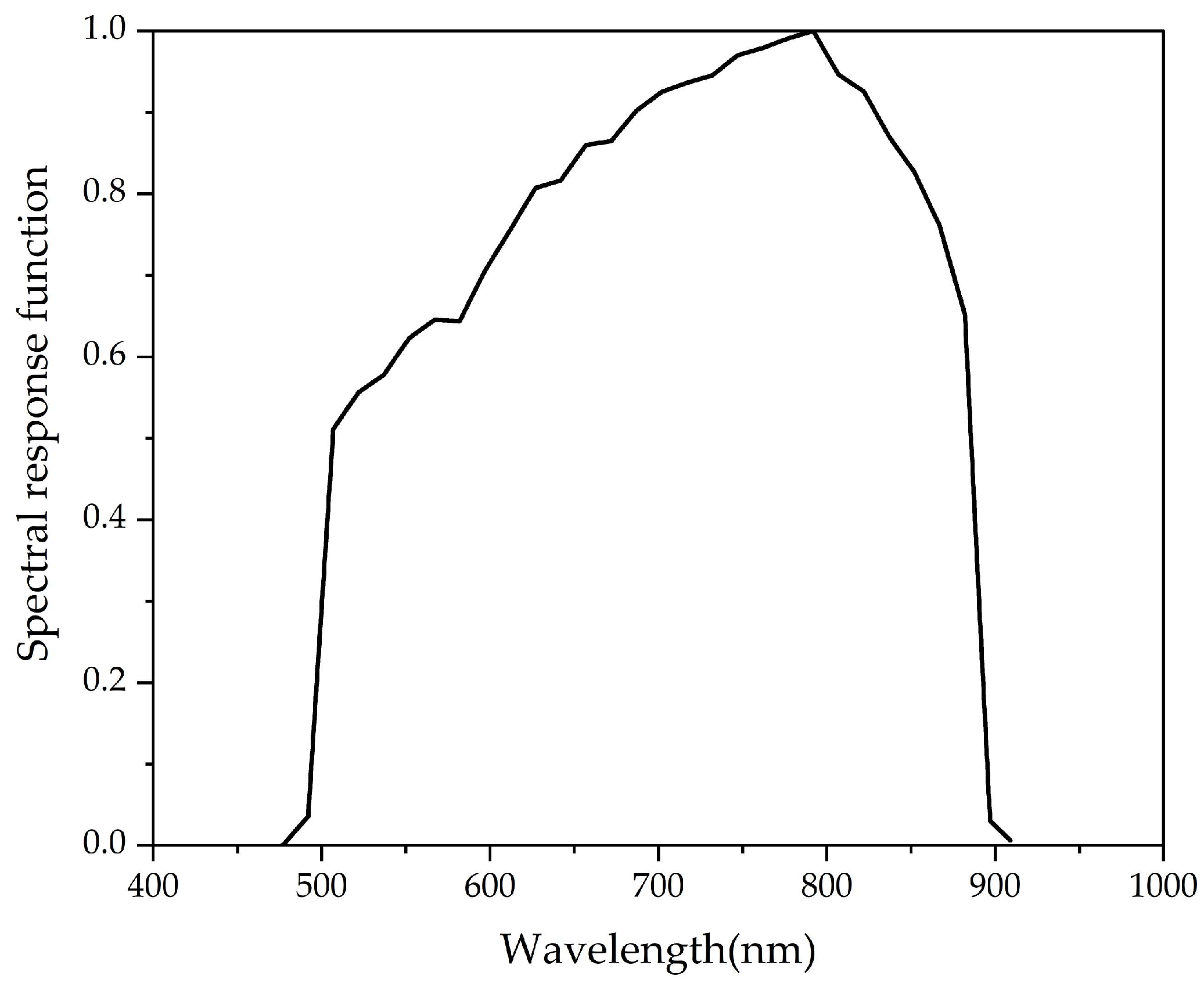
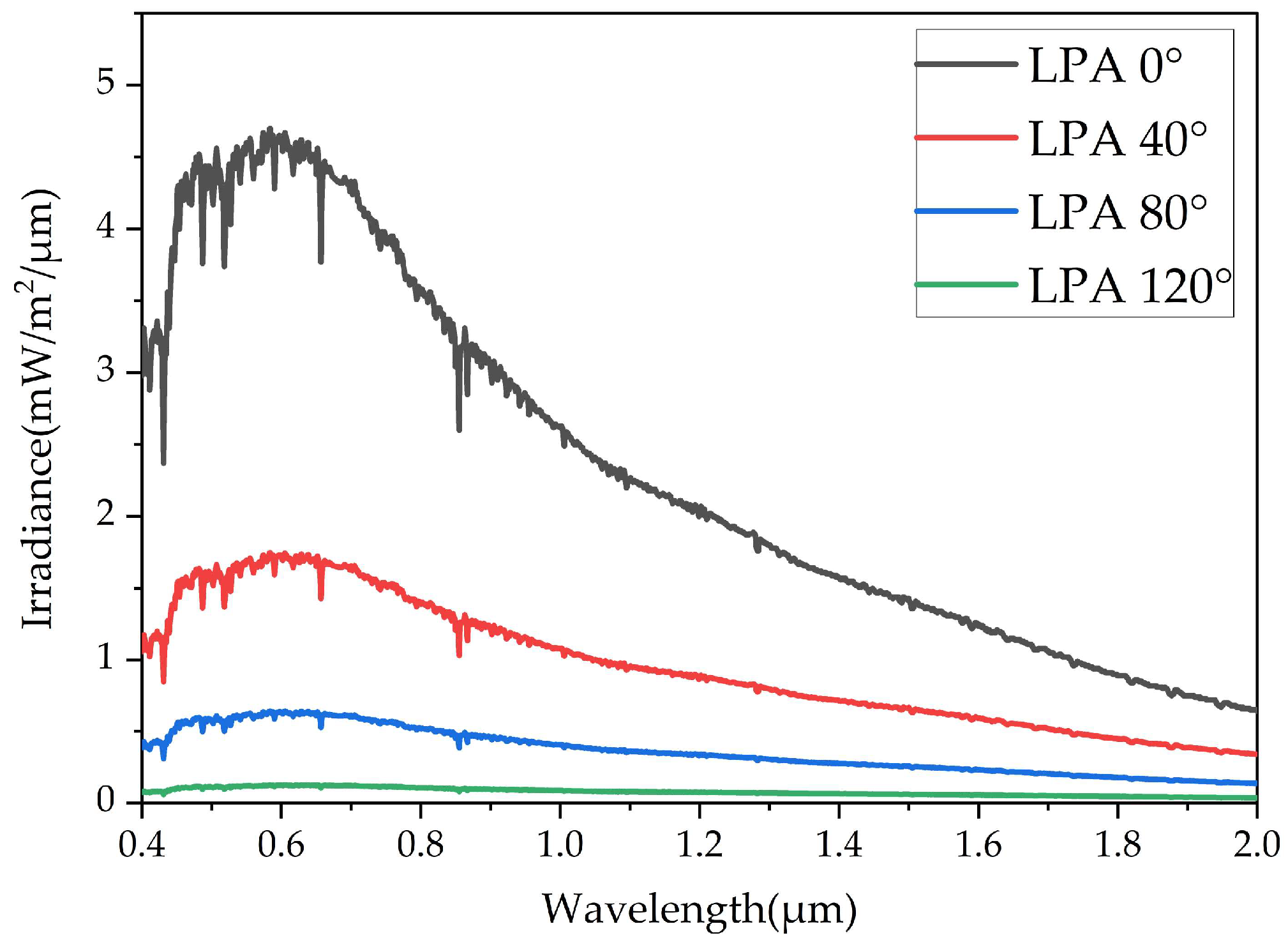
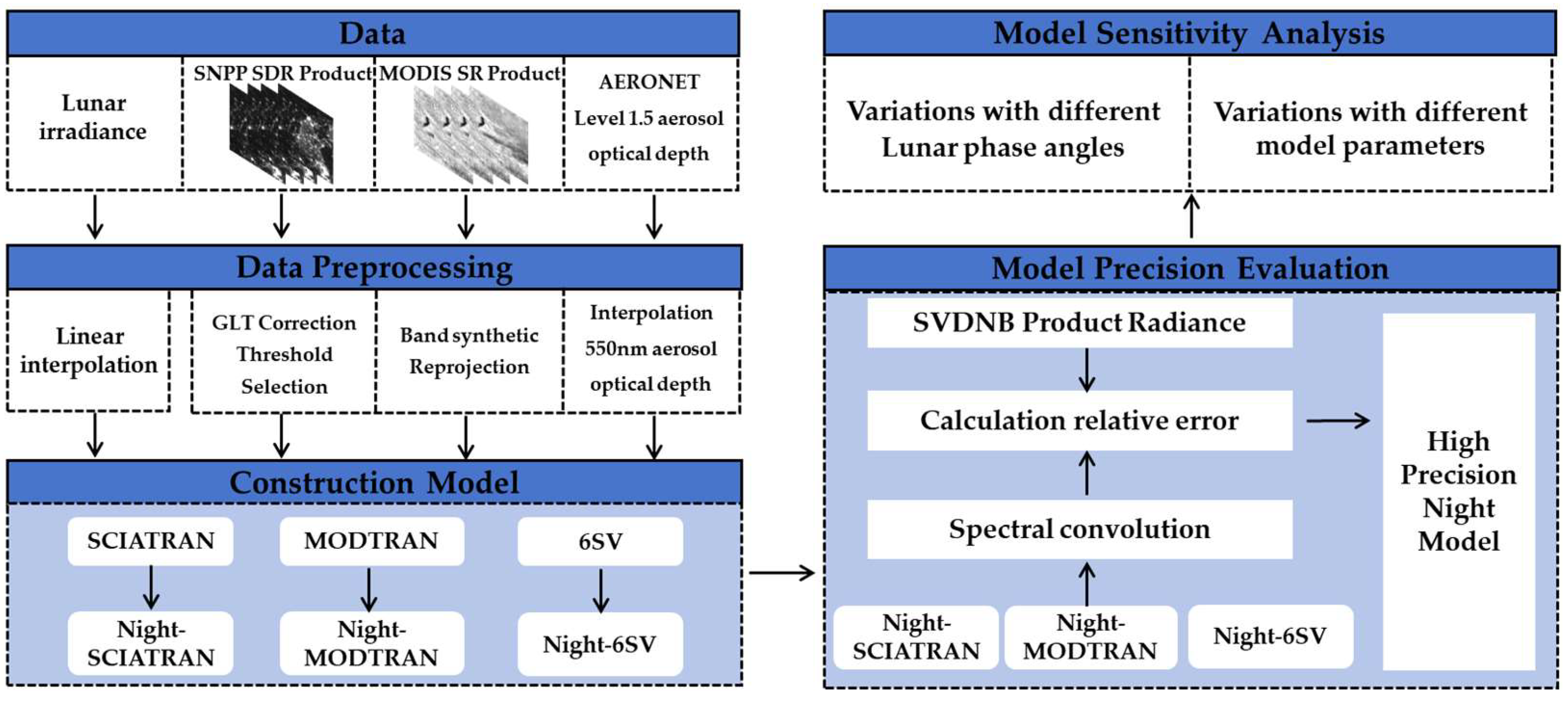
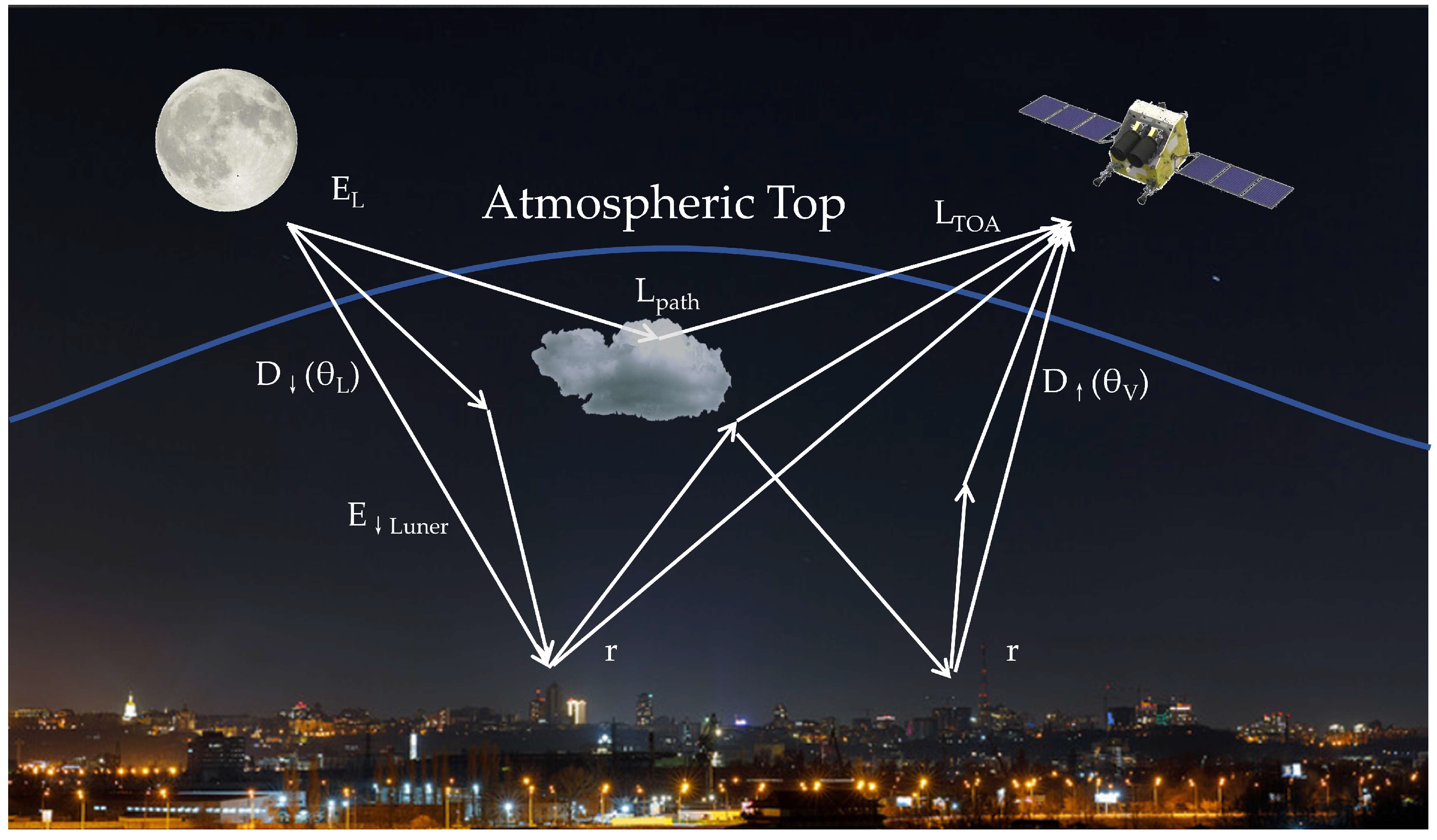
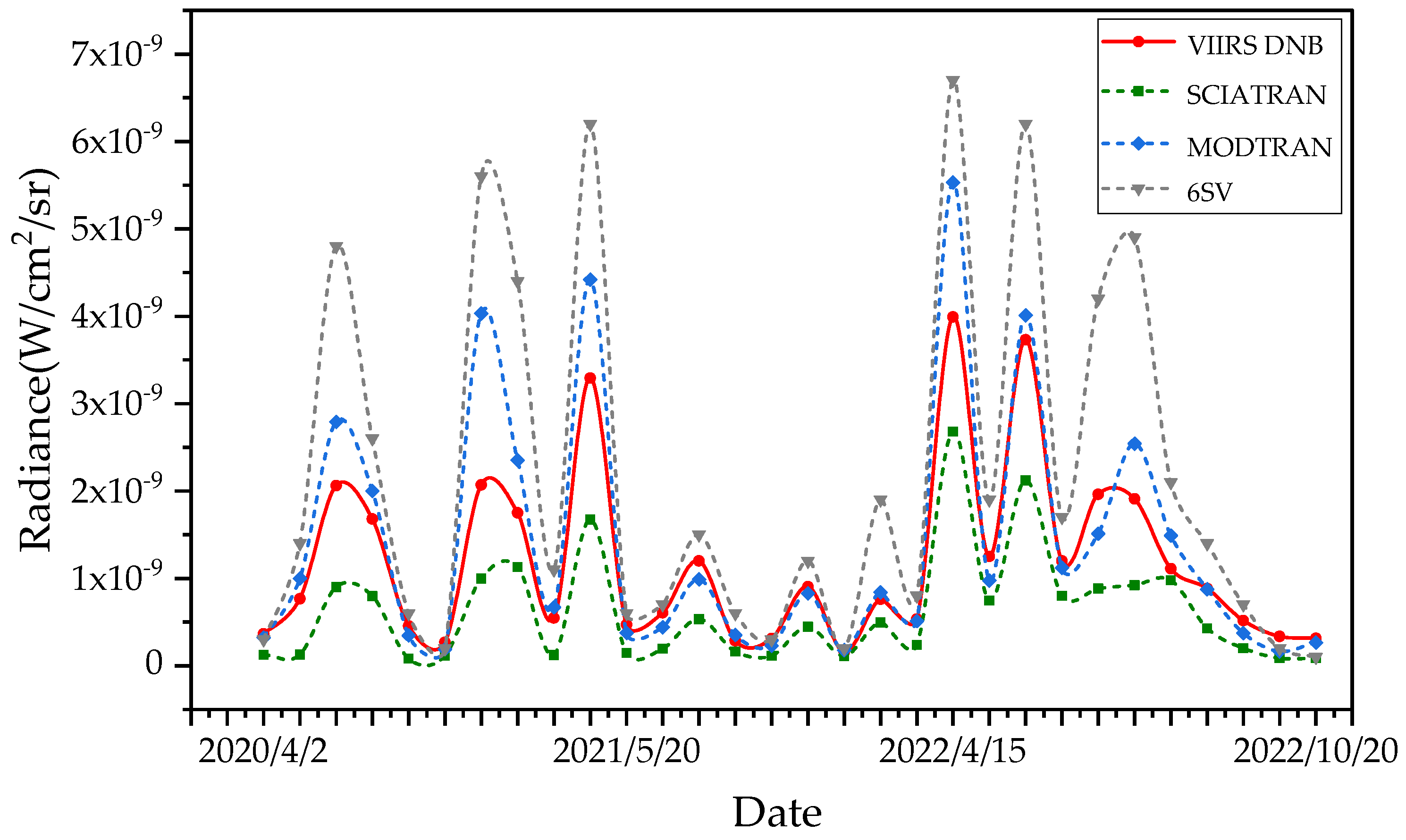

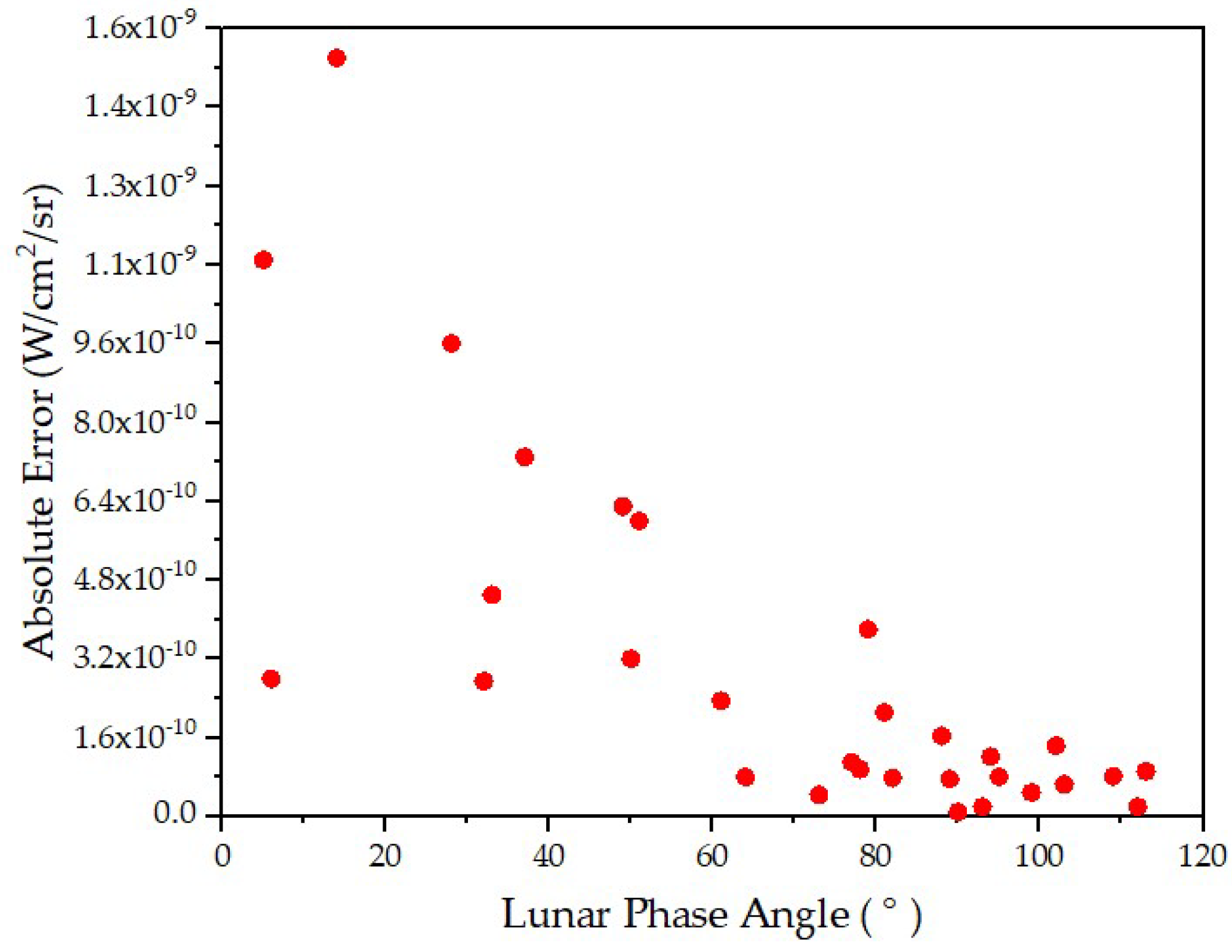
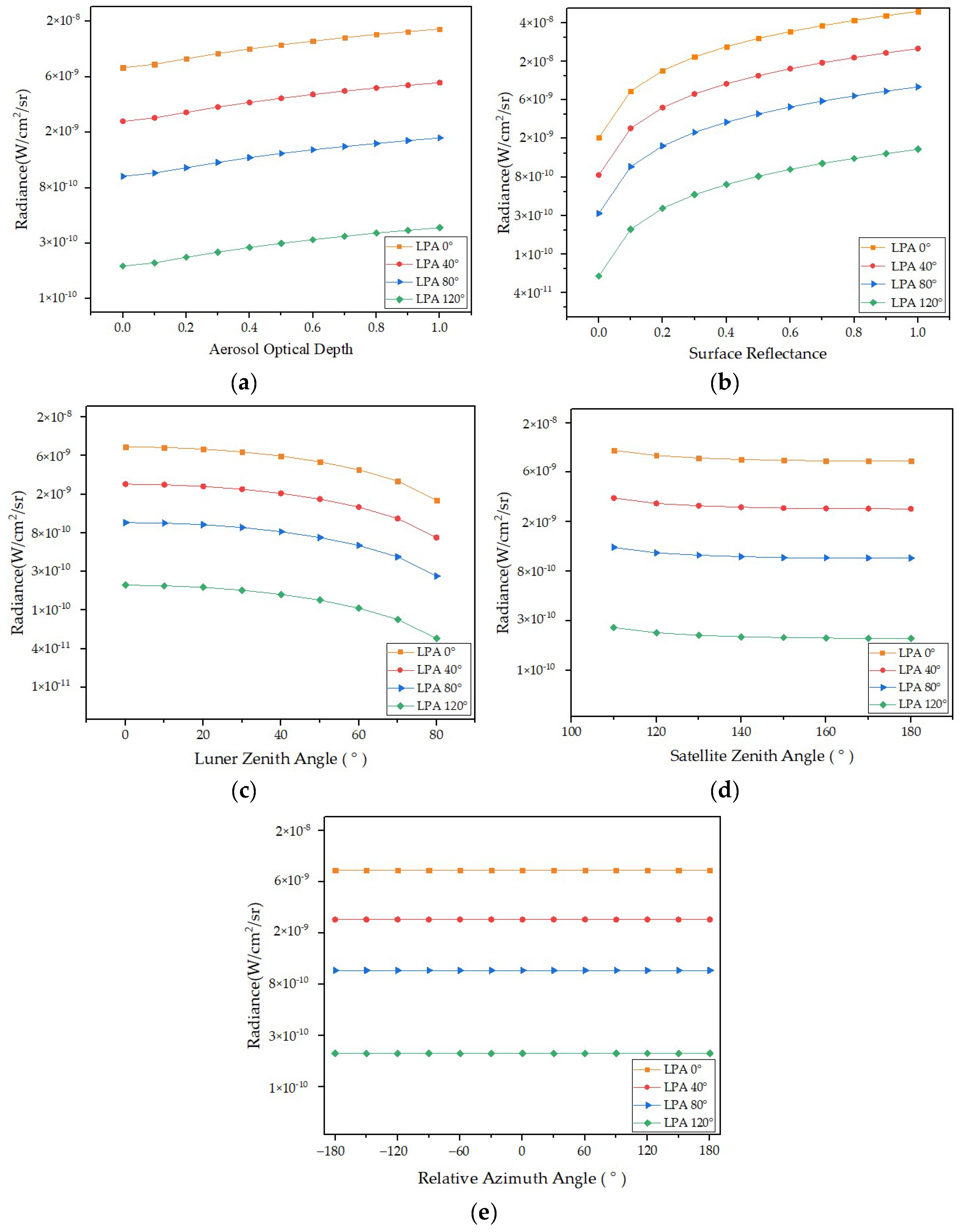
| Data | Product/Model | Spatial/Spectrum Resolution | Date/Waveband |
|---|---|---|---|
| Nighttime Light Data | SVDNB, GDNBO | 750 m | April 2020 to November 2022 |
| Surface Reflectance Data | MCD43A4(C6) | 500 m | April 2020 to November 2022 |
| Aerosol Optical Depth Data | AOE_BaoTou site | ground station | April 2020 to November 2022 |
| Lunar Irradiance Data | MT2009 | 1 nm | 400 nm to 2000 nm |
| Parameter Name | Assignments | Description |
|---|---|---|
| RTM_MODE | int | Radiance |
| RTM_TYPE | spher_scat | Spherical Atmospheric Scattering Model |
| RTM_CORE | DOM | Discrete ordinate method |
| Extra-terrestrial solar flux | File | Extracting spectral data from designated files |
| Spectral segment info | 1 492.5, 833, 0.5 | Choice of Expression and Band Range |
| Forward model: trace gases | all | Consider all trace gases |
| Line absorber treatment | esft | Linear Absorbing Gas |
| Aerosol settings | advanced | User-defined aerosol parameters (as controlled by the control_aer.inp file) |
| Latitude & Longitude | 40.85, 109.62 | Longitude and Latitude of research region |
| Module | Parameter Name | Assignments |
|---|---|---|
| Module 1 | Model Atmosphere | MidLatitude Summer |
| Type of Atmospheric Path | Slant Path to Space or Ground | |
| Mode of Execution | Radiance with Scattering | |
| Execute with Multiple Scattering | MS on Flux at Observer | |
| Scattering Algorithm | DISORT algorithm | |
| Surface Reflectance | 0~1 | |
| Solar Database Option | User-supplied file | |
| Module 2 | Aerosol Model Used | Rural–VIS = 23 km |
| Seasonal Modifications to Aerosols | Spring-Summer | |
| Surface Meteorological/Visible Range | 0~1 | |
| Module 3 | Zenith Angle (deg) | 0~180 |
| Radius of Earth (km) | 6371 | |
| Initial Frequency (nm) | 500 | |
| Final Frequency (nm) | 900 | |
| Day of Year | 1~365 | |
| Azimuth Angle of Observer LOS (deg) | −180~180 | |
| Lunar Zenith Angle (deg) | 0~90 |
| Line Number | Input Parameter | Description |
|---|---|---|
| 1 | 0 | User selects geometric conditions |
| 2 | 40 50 20 30 7 7 | Input geometric condition parameters: solar zenith angle, solar azimuth angle, satellite zenith angle, satellite azimuth angle, month and day. |
| 3 | 2 | Mid-latitude summer atmospheric patterns |
| 4 | 5 | Aerosol model is desert-type |
| 5 | 0 | The chosen method for aerosol content input is 550 nm optical depth |
| 6 | 0~1 | Aerosol Optical Depth |
| 7 | −1.27 | The target altitude is 1.27 km |
| 8 | −1000 | Sensors on Satellites |
| 9 | 100 | Spectral conditions for the VIIRS/DNB channel (user-defined) |
| 10 | 0 | Uniform surface |
| 11 | 0 | Unidirectional reflection characteristics |
| 12 | 0~1 | Surface reflectance |
| 13 | −2 | No Activation of Atmospheric Correction Method |
| Model | Average Relative Error | Uncertainty |
|---|---|---|
| Night-SCIATRAN | −14.8% | 8.2% |
| Night-6SV | 66.6% | 8.8% |
| Night-MODTRAN | 3.1% | 2.5% |
| Atmospheric Radiative Transfer Model | Lunar Irradiance Model | Evaluation Accuracy | Reference |
|---|---|---|---|
| MODTRAN | ROLO | −6.1% ± 8.9% | Liao et al. [17] |
| SCIATRAN | MT2009 | −6.2% ± 8.6% | Hu et al. [20] |
| MODTRAN | MT2009 | 3.1% ± 2.5% | This study |
| Input Parameter | Reference Value | Input Range | Parameter Setting |
|---|---|---|---|
| Lunar phase angle | 0° | 0°~120° | Interval 40° (4 groups) |
| Aerosol optical depth | 0.1 | 0~1 | Interval 0.1 (11 groups) |
| Surface reflectance | 0.1 | 0~1 | Interval 0.1 (11 groups) |
| Lunar zenith angle | 0° | 0°~80° | Interval 10° (9 groups) |
| Satellite zenith angle | 180° | 110°~180° | Interval 10° (8 groups) |
| Relative azimuth angle | 0° | −180°~180° | Interval 40° (13 groups) |
Disclaimer/Publisher’s Note: The statements, opinions and data contained in all publications are solely those of the individual author(s) and contributor(s) and not of MDPI and/or the editor(s). MDPI and/or the editor(s) disclaim responsibility for any injury to people or property resulting from any ideas, methods, instructions or products referred to in the content. |
© 2024 by the authors. Licensee MDPI, Basel, Switzerland. This article is an open access article distributed under the terms and conditions of the Creative Commons Attribution (CC BY) license (https://creativecommons.org/licenses/by/4.0/).
Share and Cite
He, J.; Zhang, W.; Liu, S.; Zhang, L.; Liu, Q.; Gu, X.; Yu, T. Applicability Analysis of Three Atmospheric Radiative Transfer Models in Nighttime. Atmosphere 2024, 15, 126. https://doi.org/10.3390/atmos15010126
He J, Zhang W, Liu S, Zhang L, Liu Q, Gu X, Yu T. Applicability Analysis of Three Atmospheric Radiative Transfer Models in Nighttime. Atmosphere. 2024; 15(1):126. https://doi.org/10.3390/atmos15010126
Chicago/Turabian StyleHe, Jiacheng, Wenhao Zhang, Sijia Liu, Lili Zhang, Qiyue Liu, Xingfa Gu, and Tao Yu. 2024. "Applicability Analysis of Three Atmospheric Radiative Transfer Models in Nighttime" Atmosphere 15, no. 1: 126. https://doi.org/10.3390/atmos15010126
APA StyleHe, J., Zhang, W., Liu, S., Zhang, L., Liu, Q., Gu, X., & Yu, T. (2024). Applicability Analysis of Three Atmospheric Radiative Transfer Models in Nighttime. Atmosphere, 15(1), 126. https://doi.org/10.3390/atmos15010126







